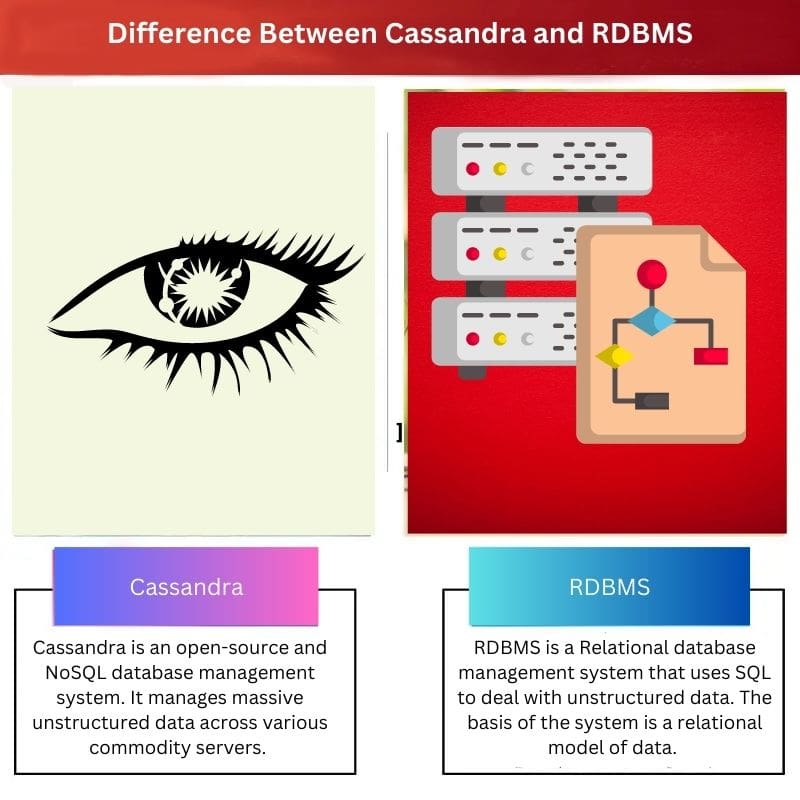Many companies need database management for creating, maintaining, and access to databases to store relevant information.
Data may be structured or unstructured, as well as related or non-related. And different schema is perverted for further handling.
RDBMS is identified as the modified underlying database model for relational database management. Also, the updated system, Distributed Database Management system, shows additional features.
One of the database management systems is Cassandra and RDBMS. Cassandra works as a distributed Management system, whereas RDBMS the relational.
Key Takeaways
- Cassandra is a NoSQL database designed for high availability and scalability, while RDBMS is a traditional relational database management system.
- RDBMS uses structured query language (SQL) for data management, whereas Cassandra uses its query language, CQL.
- Cassandra excels in handling large amounts of unstructured data, while RDBMS is better for structured data and enforcing data integrity.
Cassandra vs RDBMS
Cassandra deals with unstructured data, while RDBMS deals with structured data. Cassandra handles high-volume incoming data velocity, while RDBMS handles moderate incoming data velocity. Cassandra is a NoSQL database and has a flexible schema, while RDBMS uses SQL and has a fixed schema.

Cassandra is freely accessible software that administers massive databases across many commodity servers. Data contained by the system is unstructured and non-related.
RDBMS is a relational database management system that manages data using SQL(structured query language). Generally, it deals with structured and related data.
Comparison Table
| Parameters of Comparison | Cassandra | RDBMS |
|---|---|---|
| Accessibility | It is freely accessed. | It may or may not be freely accessed. |
| Location of stored data | In Cassandra, data can be stored in multiple locations. | In RDBMS, it can be stored one or a few locations. |
| Type of data | It manages unstructured and non-related data. | It manages structured and related data. |
| Type of schema | In Cassandra, the flexible schema works. | While in RDBMS, fixed schema works. |
| SQL or NoSQL database | It has NoSQL database management | It has SQL database management. |
| Representation of row | The unit of replication in Cassandra is row. | While in RDBMS, it represents a single record. |
| Representation of column | A column represents a unit of storage. | In RDBMS, a column represents the attributes of the relation. |
What is Cassandra?
Cassandra is an open-source and NoSQL database management system. It manages massive unstructured data across various commodity servers.
The data can be handled and replicated across the globe in a masterless configuration. Besides being fast and reliable, it also offers high availability, accessibility, and faultless.
It uses NoSQL for database management. An alternative to the most widely used database management system. Also, it uses tables, rows, and columns, unlike RDBMS.
Data is not only stored in one single location but in various locations. It can be stored in various locations or interconnected computers spanning a single area. However, data is organized horizontally and is non-related.
The language used is Java in Cassandra to make it faster and securable. Also, higher optimization and advanced memory optimization are provided.
What is RDBMS?
RDBMS is a Relational database management system that uses SQL to deal with unstructured data. The basis of the system is a relational model of data.
Its basic functionality is dealing with unstructured and related data using structured query language with a fixed schema. Besides, data in RDBMS is dense and defined while it’s assembled vertically.
RDBMS doesn’t deal with massive amounts of data but deals with a moderate amount of data at average speed. The term “relations” refers to data stored in tables.
Usually, the database of IT companies is relational. Therefore, the majority of IT companies use RDBMS for managing their data.
RDBMS makes management and accessibility easier and simpler while setting up the data in an organized, adjustable, and without error.
Main Differences Between Cassandra and RDBMS
These are some of the most commonly used database management, whereas their functionality and basics are diverse. The main difference is structure, usage of SQL, and relation of data.
- Cassandra organized horizontally. RDBMS, on the other hand, is organized vertically.
- Cassandra has faster and higher performance than RDBMS.
Moreover, Cassandra has NoSQL database management, and RDBMS has SQL database management. Even the location for stored data is different for both.


The references provided offer additional resources for further exploration of the differences between Cassandra and RDBMS.
The comparison of the representation of rows and columns in Cassandra and RDBMS offers valuable insights into their underlying data models.
The explanation on the main differences between Cassandra and RDBMS effectively outlines the key distinctions that make each database management system unique.
The detailed explanation of Cassandra’s handling of unstructured data as opposed to the structured approach of RDBMS is quite informative. It highlights the strengths of each system in managing different types of data.
The comparison table neatly summarizes the key differences between Cassandra and RDBMS, making it easier to grasp the distinctions between the two.
The explanation provided is quite clear in distinguishing the features of Cassandra and RDBMS. It helps to understand their specific purposes.
Cassandra and RDBMS offer different approaches to data management. The scalability of Cassandra seems to make it well-suited for large-scale applications.
Thanks for the insightful comparison. It’s interesting to see the differences between the two database management systems.
The comparisons of Cassandra and RDBMS in terms of their performance, schema, and data management provide a comprehensive view of their capabilities and limitations.
The detailed overview of Cassandra and RDBMS helps in understanding the specific use cases for each system and their respective advantages.